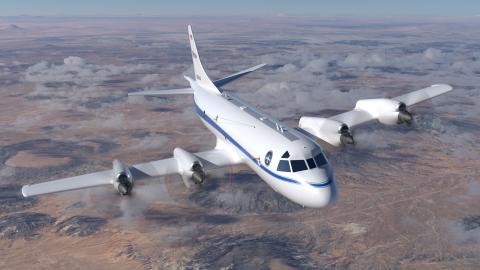
| Maintenance & Nadir #2 Port Upgrade (ends 04/04/25) |
NASA Goddard Space Flight Center’s (GSFC) Wallops Flight Facility (WFF) Aircraft Office operates the NASA Airborne Science Program's P-3 Orion (N426NA). The P-3 is a self-sufficient, four-engine turboprop aircraft designed for endurance and range. This aircraft operates out of civilian and military airfields supporting scientific research in remote areas of the world. WFF has operated the P-3 since 1991 for a wide range of scientific activities, including ecology, meteorology, atmospheric chemistry, cryospheric research, oceanography, soil science, biology, and satellite calibration/validation. The P-3 is also used as a technology test bed for new airborne and satellite instrumentation.
The P-3 has been extensively modified to support airborne scientific research. Features include zenith ports, three nadir ports (aft of the wings), and seven P-3 and DC-8 style windows that have been modified to provide externally mounted experiments. Additionally, there is are tail cone ports, nose radome ports, and ten mounting locations on the wings. Most of the fuselage ports are contained within the pressurized cabin environment while a custom fairing allows the unpressurized bomb bay to be converted into experimenter ports. This fairing creates two large nadir ports and several oblique ports for large sensors and antennas. When the bomb bay fairing is removed and the bomb bay doors installed, the doors are functional in flight to support aerial deployments. Dropsonde and sonobuoy deployment systems are also available.
The P-3 is an all-weather aircraft with modern avionics. Along with an upgraded cockpit, the P-3 has an Airborne Science Program network providing data and video throughout the cabin. This data system is connected to two satellite constellations providing uplink/downlink capability, internet access, flight tracking, and instant messaging between other aircraft and ground assets. Several sensors are connected to the data system to provide meteorological and aircraft positional data to researchers.
The GSFC/WFF Aircraft Office is committed to providing safe, reliable, and cost-effective platforms for airborne research.
* The performance numbers presented below are based on a 135,000lb Maximum Normal Take Off Weight. However, 139,760lbs is the Maximum Gross Take Off Weight.
** Airspeed indicated below is Knots Indicated Airspeed (KIAS). Maximum values shown, aircraft typically limited to 300KIAS to reduce fatigue.
*** NOTE: The P-3 will be transitioned from NASA GSFC/WFF ownership to NASA Langley ownership late FY25. The aircraft will be unavailable from 8/1/25 to 7/31/26.***

